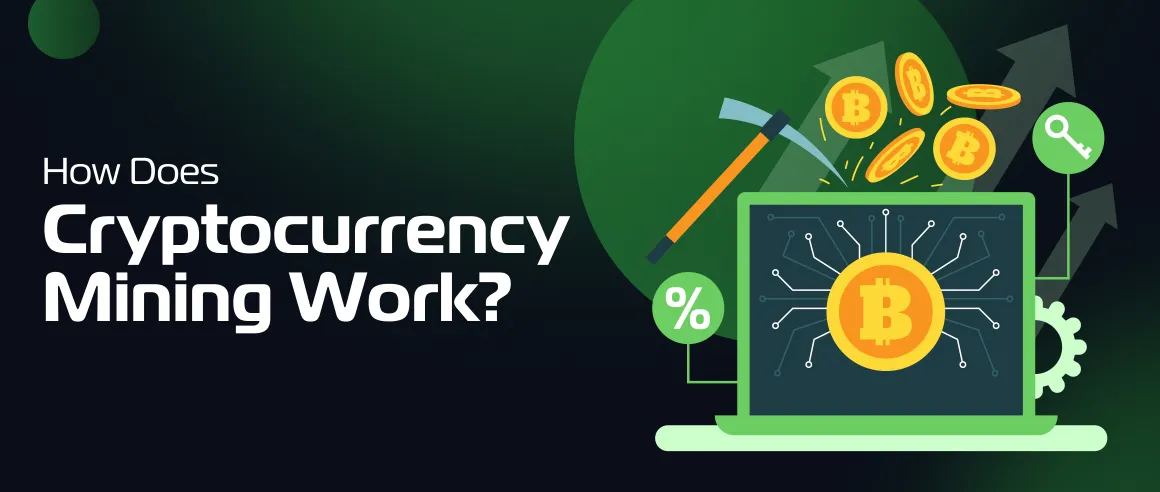Everybody has heard about cryptocurrency mining and the people installing graphic card arrays in their flats. Why are they doing this? What is happening? For what are they getting money? We are going to answer these questions here.
Cryptocurrency mining is essential for many cryptocurrencies and underlying blockchains to work. Some blockchains do not require mining because of their mechanism of work. The difference between cryptos that need mining and cryptos that do not is their consensus mechanism.
A consensus mechanism refers to achieving agreement between all blockchain participants. For example, to verify transactions and reach consensus in Ethereum, you must put 32 ETH on stake.
Read more about crypto staking
The Ethereum blockchain uses a Proof-of-Stake consensus mechanism, where verifying agents need collateral. PoS is less energy-intensive than Proof-of-Work precisely because the latter uses mining. Let’s talk more about that.
Proof-of-Work consensus mechanism
Let’s take Bitcoin as our example of PoW-based crypto. Miners are responsible for the transaction validation process in the PoW consensus mechanism. They use vast amounts of energy to add transactions to the blockchain and prevent double spending when the same crypto is spent twice. Miners create new blocks in the blockchain while mining. Those blocks are just continuous lists of transactions linked to each other, forming a chain. Miners get rewarded with newly issued Bitcoins for the work they do. Since Bitcoin is finite, the reward for each block regresses, getting twice less approximately every four years. When all 21 million Bitcoins are mined, the newly minted Bitcoins will no longer be paid to miners. Transaction validators will earn only transaction fees.
Risks and challenges of mining
Remember we mentioned Ethereum? Before 2022, it was PoW. Why did the consensus mechanism change to PoS? This is primarily due to the poor energy efficiency of PoW-based blockchains. When Ethereum started hosting various DeFi services and NFTs, its energy consumption skyrocketed and breached all known boundaries. Because of that, especially since there are so many use cases of Ethereum, the platform faced horrific criticism, with people demanding that the crypto community stop using Ethereum and NFTs. The transition to PoS has silenced the angry voices.
The PoW cryptos like Bitcoin are still criticized for their carbon emissions. However, since Bitcoin’s function is limited to a payment system, the impact remains below the level of massive public outrage.
Another issue for miners is Bitcoin’s volatility. Since mining is a financially demanding process, miners need a sufficient profit margin, which becomes difficult during some crypto winters when Bitcoin can fall to $20,000. This is while energy prices and computer parts soar worldwide! The problem becomes especially relevant during halving events when mining rewards decrease by two. Depending on your infrastructure and electricity contract, mining can become unprofitable at any moment.
Lastly, cryptocurrency mining faces legal challenges. The nature of these challenges differs by country. Some countries support miners or at least do not penalize them. Others impose higher tax rates and have miners pay electricity bills with increased tariffs. For example, China, a prominent mining nation, has banned cryptocurrency mining since 2021. The reason was that, according to Chinese government officials, mining facilitates financial crimes and interferes with the “normal” economics of the PRC. While this measure is unique in its decisiveness and extensiveness, many other governments try to limit mining in other, more subtle ways.
Becoming a miner
There are several main steps to set up a crypto mining rig. The process starts with hardware procurement. Bitcoin, Litecoin, and a handful of others need a setup based on Application-Specific Integrated Circuits (ASICs). Other cryptos need a GPU rig. When you acquire the required system or assemble it on your own, the next step is to install mining software. For an ASIC-based system, you need the CGMiner. For a GPU rig, use the EasyMiner. The setup process for this software is described in more detail in the manuals.
Choosing the crypto to mine
When choosing the proper crypto, the main driver should be its potential profitability. Mining is a business. You should enter it with all your costs and risks thoroughly calculated. Of course, regions with low electricity prices are best for mining. The most likely answer to the question “What crypto to mine in 2024?” is neither surprising nor intriguing: Bitcoin remains one of the most profitable cryptocurrencies due to its stably-rising price and low (by the crypto market standards) volatility.
If you are thinking of starting mining, look at KvaPay’s wallet: our business account features automatic cryptocurrency conversion to fiat currencies. Get your rewards and swap them for EUR or CZK with no fees or delays!
Tags:
Share:

